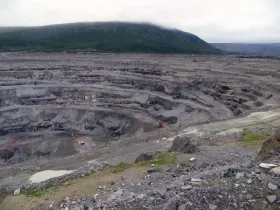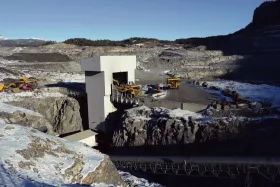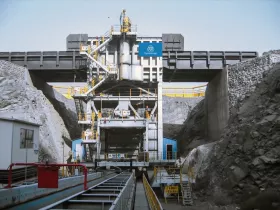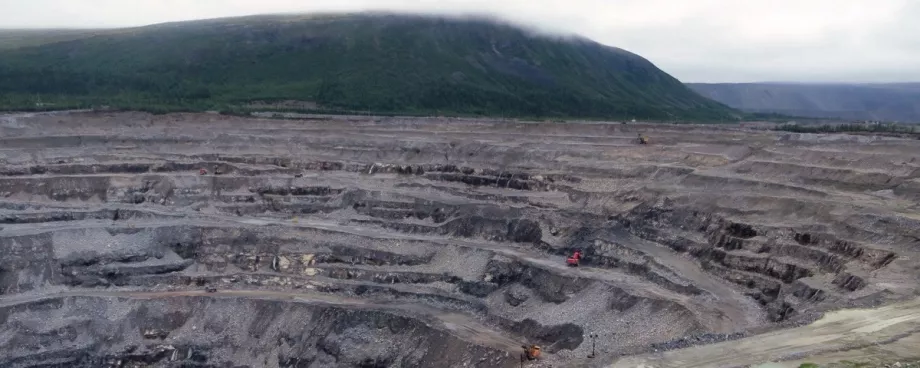
In June 2015, Thyssenkrupp Industrial Solutions secured a contract to develop and construct an In-Pit Crushing & Conveying (IPCC) system for the Koashvinsky phosphate mine. This mine, operated by OJSC Apatit, a subsidiary of Russian fertilizer producer PhosAgro, is located near the city of Kirovsk on the Kola Peninsula in northern Russia, an area known for its high-quality phosphate ore. Phosagro/Apatit operate several open pit and underground mines here and extracted some 2,5 million tons of ore in the 2015/2016 production period. The ore is processed in a central processing plant and shipped to users in all parts of the world.
The Koashvinsky-IPCC system will be the first of its kind in a Russian open-pit mine. It is aimed to replace the truck haulage of waste materials outside of the mine. Instead, these materials will be crushed to a conveyable size with the new high-capacity crushing plant, and transported by curved conveyor over a distance of around four kilometres to an external waste site. At the end destination, a crawler-mounted spreader with an hourly capacity of 6200 tonnes will discharge the material from the conveyor.
The semi-mobile, direct-feed crushing plant is equipped with a gyratory crusher designed to accept 6200 tonnes of material per hour. The system’s hoppers have sufficient design capacity to accept trucks with a payload of up to 220 tonnes.
The IPCC system will substantially cut operating and maintenance costs as well as lower CO2 emissions. It will also provide a higher level of operational safety.
Design and Planning
Thyssenkrupp began the project in 2014 with the full involvement of Apatit engineers. Design, construction and choice of crushing equipment were selected considering the following material characteristics:
- compressive strength,
- tensile strength,
- cleavage,
- fracture behaviour and,
- adhesiveness/humidity
The IPCC system designed for Apatit’s Koashvinsky mine is a combined crushing unit able to handle both hard waste and moraine material, and has the capacity to handle up to 30 million tonnes of waste a year. The system needed to be able to accept materials with compressive strengths averaging 50-190 MPa up to a maximum of 320 MPa. The size and design of equipment was based on the following material properties:
- specific in-situ density: 2.8 t/m³
- swell factor on belts: 40%,
- specific loose weight: 2.0 t/m³ and,
- max. moisture content: 3% run of mine
As part of the project, Thyssenkrupp arranged visits to a number of European reference sites where other long-distance curved conveyors and crawler-mounted spreaders are currently installed and operating.
Location

Semi-mobile IPCC systems are generally located deep inside opencast pits as near as possible to the material being mined. Their mobility allows the systems to be relocated using transport crawlers as mining progresses.
For the Koashvinsky mine, it was decided to locate the direct-feed crushing plant not inside but close to the existing mining operation. The transport conveyor needed to be routed across road and rail crossings and fit the local topography. At least one curved conveyor section was necessary to ensure the most economical and environmentally-acceptable route.
The Benefits
With an IPCC system, truck haulage is only used to move material inside the open mine pit. The use of trucks is greatly reduced and restricted to shuttling material, horizontally or downwards, to the semi-mobile crushing plant. In terms of operational expenditure (OPEX), IPCC has the following advantages versus a conventional system using diesel trucks:
- It is electrically driven with a higher efficiency than diesel motors.
- With regular maintenance it has a service life of up to 40 to 50 years.
- It significantly reduces operating personnel due to partial automation.
- It increases mine safety and utilisation.
- It reduces CO2 emission (depending on the origin of the electricity used).

Although the investment costs are always higher for a mobile or semi-mobile IPCC system, the reduced OPEX typically leads to a return on investment within 2-4 years of successful commissioning and operation.
“The switch to the new IPCC system is expected to lead to a significant decrease in truck haulage in the Kirovsk mine,” comments Thomas Jabs, head of Mining Systems within the Mining Technologies business unit of Thyssenkrupp Industrial Solutions. “Thus, our customer will profit not only from a substantial reduction in operating and maintenance costs, as well as lower CO2 emissions, but also from a higher level of safety during operation.”
Co-operation
The IPCC project with Apatit is being delivered through a joint German-Russian team. Two of Thyssenkrupp’s mining technology subsidiaries in Germany – Mining Systems and Processing – are collaborating with local partner Thyssenkrupp Russia. The IPCC system at Koashvinsky mine is scheduled to be erected and commissioned in 2018. Local Russian companies are also deeply involved with the project and are working closely with thyssenkrupp.
■





















